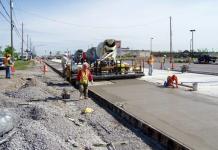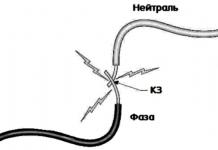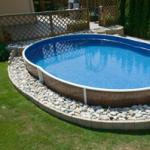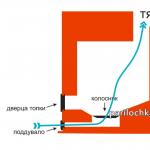The issue of building roads with cement concrete pavement in Russia is becoming especially relevant today, when the government of the Russian Federation has defined the strategic task of almost doubling the service life and at the same time reducing the costs of construction, repair and maintenance of roads. One of the possible ways to achieve this goal is the use of cement concrete coatings.
Why are cement concrete roads not being built in the country yet? To understand this, we need to look at history. In Germany and the USA, already before the Second World War, highways with cement concrete pavements were actively built. In the USSR, the first such routes appeared only in the 50s of the twentieth century. At the same time, domestic rail-mounted laying machines D181, D182, D195 were created.
Since 1970, the USSR began mass construction of cement concrete roads using new technology - machines with sliding formwork on caterpillar tracks. Sets of high-performance concrete-laying complexes "Autograde" were purchased in the USA. They became the basis for the production of sets of domestic machines D100, D110 from the Bryansk plant. Using innovative technology at that time, the Moscow-Volgograd, Omsk-Novosibirsk, Sverdlovsk (now Yekaterinburg)-Chelyabinsk, Sverdlovsk-Serov, MKAD-Podolsk-Serpukhov, and MKAD-Kashira routes were built. " and many others.
At that time, the length of roads with cement concrete pavements was more than 10 thousand km. However, during the operation of such roads, a number of shortcomings emerged: they developed opening cracks in transverse expansion joints, peeling, crumbling of the surface layer of concrete, and chips occurred. Why did it happen so? Most likely, the country was simply not ready for the construction of cement concrete roads. There was no high-quality cement, effective plasticizing air-extracting additives, high-quality sealing materials, and GOST standards and technical control standards were not developed. As a result of this complex of reasons, the road surfaces actually became unusable after a year.
When mass destruction of cement concrete pavements began, which arose due to poor-quality materials and non-compliance with technology, the Ministry of Transport issued an order to freeze the construction of roads of this type in the USSR. Since 1980, construction began to wind down, the number of projects was reduced, and scientific research was suspended. Regulatory documents in this area have not been updated for more than 30 years! At that time, there was an erroneous stereotype that it was impossible to build high-quality cement concrete pavements in Russia, that they were expensive compared to asphalt concrete. In fact, large contracting organizations were liquidated, and many of their employees went abroad. Thus, Tsentrodorstroy specialists ended up in India in the 80s, where they built more than 500 km of high-quality road surfaces.
Years have passed, and the “portrait” of the cement concrete road has changed a lot. Now a new technology has been introduced into world practice, which implies almost complete automation and mechanization of all processes for laying and compacting, and constructing expansion joints. Modern concrete pavers perform a full range of work in one pass, leaving behind completely finished coatings! It is also important that today there is no shortage of quality materials. A new generation of high-strength concrete has been created, and sealing materials with a service life of seven or more years are available.
It has been proven that the cost of cement concrete road pavements is approximately equal to the cost of asphalt concrete pavements. Previously, the thickness of the cement concrete layer was at least 20 cm, and the asphalt concrete coating, approximately 5 cm thick, was laid on a twenty-centimeter base of crushed stone. In this situation, asphalt concrete was cheaper. However, now, when the loads on the roadway have increased, the total thickness of the asphalt layers is 24-26 cm, and the cement concrete layers are 22-24 cm, that is, they are actually equal.
The main advantage of cement concrete is its service life without repairs. If a road with asphalt concrete pavement needs to be repaired after 2-3 years, then a cement concrete road needs to be repaired after 26-30 years. In America, they switched to the construction of ultra-durable coatings, the service life of which is 50 years. The myth about the irreparability of cement concrete pavements has also been completely dispelled.
Now the moment has come when Russia has approached the need to build cement concrete roads. The Association of Concrete Roads has been created, which purposefully promotes the idea of the need for mass use of cement concrete in Russian road construction, filling the existing vacuum in the field of regulatory documentation. The point is that all projects for the construction and reconstruction of roads must present an economic comparison of different options. And if the calculation takes into account discounted costs, cement concrete will be more efficient. It is important that today there is a technological base for this, as well as a social order to reduce construction and repair costs and increase the service life of road surfaces. If there are orders, Russian laying machines and new contractors will definitely appear.
Opinion
Vitaly Bogachenko(LafargeHolcim Russia): “Roads with cement concrete pavement are widespread and durable in use. Modern monolithic cement concrete pavement is smooth and rigid, its life cycle is three times longer than that of asphalt concrete. The obvious advantages of cement concrete pavements include: significant service life (more than 25 years, no deflection of the road surface), low susceptibility to temperature fluctuations, reduced energy consumption and increased traffic safety due to increased reflective properties. It is important to note that the cost of constructing cement concrete pavements can range from 95 to 130% of the cost of asphalt concrete pavements.”
Yuri Zhukov(“VirtgenInternational-Service”): “A serious problem of roads is wear and rutting during heavy traffic. One solution could be a two-layer laying of cement concrete, fresh on fresh. In this case, the top layer of higher quality concrete is laid on top of a freshly laid bottom layer of a lower grade. This work is performed by a complex of two separate concrete pavers or one specialized one. In this case, the wear resistance of the road surface is significantly increased and the cost of materials is reduced. So far, the number of roads with cement concrete pavement in Russia is small. And if a large-scale federal program for the construction of such highways is adopted, then you need to understand that the school for the construction of cement concrete road surfaces was practically lost, and there are not many specialists left. Also, for the construction of two-layer coatings, new specialized high-tech equipment will be required"
Concrete roads in the USA are an almost integral element of the landscape: the use of effective technologies for preparing the base and pouring the road surface makes it possible to obtain a fairly durable road surface that can withstand heavy traffic loads.
In Russia, the situation looks somewhat different: cast concrete and concrete slabs are considered rather as an alternative, used where it is impossible to lay asphalt. And yet, new technologies are gradually being introduced, so the appearance of such routes is also not far off.
Preparing for work
Materials for filling the canvas
When laying industrial tracks in our country, standardized concrete road slabs are most often used. On the one hand, the use of such elements significantly speeds up the work, but on the other hand, the quality of the canvas is relatively low, and therefore the surface wears out very quickly ().

Note! Particular problems are caused by joints, which over time become deformed and turn into large potholes.
That is why in private construction the technology of pouring a monolithic coating is most often used. This is what we will focus on in our article.
The estimate for constructing a concrete road using poured technology includes the following items:
- First, we need high-quality concrete. To lay highways, it is necessary to use cement meringue compositions M400 (B30) and stronger, but for the access road to a private house M300 (B22.5 - B25) is sufficient.
- Preparation of the base is carried out with the obligatory addition of sand and gravel.
- To provide the material with sufficient elasticity, it is reinforced with steel bars or reinforcing mesh. Metal parts with a cross section of 10-12 mm are used here.
- To function effectively and prevent deformations, concrete road surfaces must be divided into several sections using expansion joints. When making such seams, special sealants are used.
In addition, we will need materials for installing the formwork: boards with a thickness of at least 50 mm, fasteners, steel corner covers, pins for fixing the frame.

Pre-treatment of the area
The technology of concrete roads, described in TR 147-03 “Technical recommendations for the construction of road structures from cast concrete mixtures”, provides for the mandatory preparation of the base:
- We apply markings to the site selected for construction.
- According to the markings, we select the soil, removing the top fertile layer of soil and going deeper by about 60 cm in relation to the planned level of the future canvas.
- Then we pour a layer of gravel with a fraction of 40 millimeters or more onto the earthen base.. The thickness of such a layer should be about 30 cm.
- We lay a gravel-sand cushion on top, bringing it to the required level. We carefully compact the bedding using tamping machines, constantly moistening and adding new portions of material.
- To check the quality of the seal we use a steel rod with a diameter of about 10 mm. When stuck into the base, it should be deeply buried by 60-70 cm. If the rod passes the top layer with resistance, and then goes easily, you need to continue tamping, since loose areas will shrink sooner or later.
Work methodology
Installation of formwork and reinforcement

- Before starting installation, we determine the level at which the road surface will be located. It is desirable that it be slightly higher than the ground level - then dirt will not accumulate on the roadway.
- Also, when designing a driveway to a house, it is advisable to include a small slope in the structure for water drainage. The optimal slope is 2-3 cm per 1 m.
- Then we install the formwork, the strength of which directly depends on the parameters of the cement layer being poured. For a road with a thickness of 100 mm, the boards should be no thinner than 50 mm, and the road surface with a thickness of 150 mm or more is erected in formwork from timber 100 mm thick.
In parallel with the formwork, we are engaged in reinforcement and installation of expansion joints:
- Along the edges of the road surface we install ribs made of steel strip.
- We lay a welded mesh with a cell size of 150x150 mm into the road itself at a distance of about 40 mm from the base.
- With our own hands we install expansion joints every 10-12 meters. For laying we use a strip of fiberboard or similar material impregnated with bitumen, as well as rubber, plastic, etc. You can put a special cover on top of the strip, which is adjusted exactly to the level of the road.

Note! After polymerization of the cement, the cover must be removed, and the groove in its place must be filled with elastic sealant.
Concrete pouring and finishing
Since concreting roads requires a large amount of material, mortar for this purpose is usually ordered from large enterprises. On the one hand, the price of the material increases slightly, but we will be able to fill a large area in one go, without interruption and avoiding the formation of stressed areas.
The filling process itself goes like this:
- Using gutters, we evenly distribute the solution from the mixer inside the formwork.
- Using rules on long handles and shovels, we perform preliminary leveling of the plane, filling areas along the ribs and removing large air cavities.
- Then, using a long rule (a flat board or a steel U-shaped profile), we finally level the surface. To make the work easier, we select a rule that is slightly larger than the width of the road - so its edges can be rested on the formwork.

- Finally, we use the so-called “bull trowel” - a wide board with a long handle. With it we remove all unevenness, while simultaneously compacting the top layer of coating.
Then we let the concrete set.
After this we carry out the final finishing:

- To avoid cracking of the fabric during drying, we cut shrink seams. For cutting, we use a special tool - jointing, going deep to at least 1/3 of the thickness of the concrete layer.
Advice! The pitch of the shrink seam is determined by multiplying the thickness of the fabric by 30.
- After jointing, we apply a relief to the surface of the material using a road brush. This way we not only improve the adhesion of the coating to the wheels, but also promote water drainage. Thanks to this treatment, the concrete road will last much longer!

Conclusion
The construction of concrete roads using the technology described above can be done independently. Of course, the project will be large-scale, and the costs will be very significant - but it can still be implemented without the involvement of professionals ().
If this method of pouring a monolithic coating interests you, we also recommend watching the video in this article, which contains additional information.
The main material used for road construction is asphalt. After a few years, such a coating needs to be repaired, then its operational properties are restored annually. Concrete pavement is much better than asphalt, but its use is limited. There are reasons for this, related to insufficient funding, low productivity levels, climatic conditions, insufficient quantities of cement of the required grades, and relief areas. This technology is not yet particularly popular in Russia, since asphalt roads are much cheaper. However, we note that gradually the cost of these types of canvas is slowly equalizing. The construction of concrete roads, bridges, and runways at airfields begins.
Advantages of concrete roads
Such coatings have certain advantages:
- The concrete road is of good strength and does not require repair work. The coating can be used for at least four decades, and for asphalt this period is limited to a decade with annual repairs;
- Automotive vehicles consume less fuel. This is due to the fact that while a heavy-duty vehicle is moving, road concrete is not subject to deformation, which means that the vehicle needs one-fifth less fuel to move;
- The coating is resistant to sudden changes in climatic conditions. It is not affected by heavy rains or sudden changes in temperature;
- air purity is maintained, because cars require less fuel, the exhaust gases of which pollute the environment;
- natural resources are used sparingly. Limestone is needed to make concrete, and petroleum is used to make asphalt.

Construction technology
The construction of concrete roads includes certain stages:
- The soil base is being prepared. It is rolled to achieve the desired density, and if necessary, moistened or dried.
- Water drainage is organized to extend the service life of the canvas and make driving safer.
- The underlying layer is installed. It is a sandy layer, the thickness of which is up to two to four tens of centimeters.
- The formwork structure is being assembled. Its elements are made of lumber, and the height of the fill is taken into account.

If water seeps into the ground, the road surface gradually deteriorates.
The construction technology is complex, and each stage will be considered in detail.
Concrete road structure
The canvas includes certain layers:
- underlying - for its construction, crushed stone is used, which drains groundwater, and sand, with the help of which the resulting loads are compensated;
- strengthening – represented by low-grade concrete that binds the backfill layer;
- road surface - concrete surface.
The construction of a concrete road for heavy vehicles is made of stressed and non-stressed reinforced concrete, the reinforcement frame in which does not allow the stone to crack from the weight of trucks.
In private types of construction work or when constructing concrete road surfaces on soils supersaturated with moisture, a waterproofing material is laid on the sand cushion to prevent severe wetting of the road surface and subsequent corrosion of stones and reinforcement. Ordinary roofing felt is used as a waterproofing material.
Execution of work
Let’s look in more detail at what this or that construction stage of road concreting is.
Preparation
Excavation work is difficult, and it is quite expensive. They are preceded by the preparation of a detailed design solution, the conclusions of which are based on geological studies of the area. If there is such a possibility, then concreting roads is done horizontally, removing small hills or placing compacted rock in the depressions.

If a large highway is being built, then the layer of fertile soil is completely removed, and to install a concrete road in the yard, it will be enough to remove fifteen to twenty centimeters of soil.
The prepared base is compacted with rollers and vibration mechanisms, which are heavy.
This stage is considered a crucial moment, since the rigidity indicator and integrity of the road surface depend on the strength of the base, even when the dynamic loads are quite intense.
During excavation work, the installation of a drainage system is considered so that it is possible to remove ground and rain moisture. For this purpose, the base is placed in a plane, the inclined angle of which is from two to four degrees. Concrete gutters are installed on the sides of the road or natural slopes are arranged, along the slopes of which water will flow into receiving wells or go into the ground.

Litter layer
A sand cushion is arranged, the thickness of which is twenty to forty centimeters. This element can be omitted, but it perfectly protects against moisture coming from the ground and improves the drainage process. The bedding layer is necessary to prevent erosion and swelling during frosts, which leads to the formation of depressions and cracks in monolithic concrete.
The most problems appear in clay, peat and other areas of the terrain that can hold water. In most cases, such layers are partially removed, and the bottom is covered with large stones and gravel. The rolled layer reaches a height of thirty centimeters. Such preparation will determine the costs and time required for construction.
The minimum base thickness depends on the type of soil and climatic conditions. It is determined using a special table. If the layer is laid out from different materials, then geotextiles are spread between them.

Level the layers in accordance with the designed slopes. Stone backfills are strengthened with binding materials - cement, granulated slag from metallurgical production, to which quicklime is added, ash from thermal power plants, ground slag.
Formwork
To make this structure, boards are used, the height of which corresponds to the level of pouring concrete for the road. As a rule, it is equal to ten to fifteen centimeters. When determining its dimensions, it is necessary to take into account that ribs are installed along the edges of the concrete to improve strength. The thickness of the boards should not be less than 5 cm. Each structural element must be coated with a special compound that will facilitate detachment from the hardened concrete.
Wooden formwork panels are subject to requirements regarding the level of strength against expansion by fresh concrete mass and the forces that will arise as a result of compaction.
If heavy machinery is used to construct roads made of concrete, which is used to compact the concrete, then formwork made of steel material should be installed. It will last much longer. Each element is based on a sole that improves stability.

The formwork sections are aligned in one line and firmly fixed. This is especially important if the vibration of the concrete mass is carried out by heavy machinery. In places where the level of the base decreases, thin concrete is poured under the formwork to improve stability.
Reinforcement
If the technological process of constructing a concrete road involves this type of work, then the reinforcement should be a metal mesh, the cell area of which reaches 150 mm. sq. This choice of material will make it possible to avoid expansion and the appearance of cracks in the concrete thickness.
The laying of the reinforcing mesh is carried out during the process of pouring the concrete mixture at a height of three to four centimeters from the lower level. Before this, the poured concrete is leveled, a frame mesh is laid, and, if necessary, fixed. Now you can continue working.
Fill
The bedding layer is covered with material that is resistant to getting wet, waterproofing, or simply moistened. Road concrete that complies with GOST is laid out in one thickness at a time. When reinforcement is applied, the process is carried out in stages.
Concrete for the road, the grade of which meets all the requirements, is applied quickly, since it does not have long-term viability. It is not recommended to add water to the mass, because the mechanical properties of the coating will deteriorate. Since the construction volumes are large, factory-prepared road cement is supplied to the work site. The mixture is unloaded one cubic meter at a time and leveled to give the entire layer the same density.
The best option for laying concrete is two or three layers.
The concrete mixture is compacted using special mechanisms, represented by wooden or metal beams, which are impacted by pneumatic hammers attached to them. Such a device is lowered into the mixture and begins to move in it. Having processed one area, the timber is moved further.
If reinforcement is used, the vibration device should be located five to seven centimeters above the top edge of the frame.

In addition to the vibration device, the special machine also has a leveling device located in front.
The concrete composition must be plastic and sufficiently mobile, but not very liquid so that it cannot float, flowing through the formwork panels. All this will negatively affect the strength of the coating.
Seam cutting
A prerequisite is the installation of expansion joints. This type of work is possible when the concrete reaches a certain strength level of 50 - 60 percent. In this form, the canvas is able to withstand the weight of not only the worker, but also a special tool for cutting seams.
In this way, thermal expansion, to which concrete is subject to varying degrees, is compensated. Road segments do not form cracks during seasonal changes.
Sawing is carried out using a jointer - a special tool. The distances between the seams are determined by design calculations. As a rule, to do this, the thickness of the monolithic coating is multiplied by thirty.

To prevent moisture from getting into such seams, they are filled with mastic.
Materials for constructing concrete sheets
M400 is a universal concrete composition. Its strength allows it to withstand loads from various wheeled vehicles. The basis is Portland cement, which is resistant to moisture. Plasticizers are also added to the solution to improve hydrophobicity and strength.
The concrete mixture consists of:
- cement – 1 part;
- crushed stones - 5 parts;
- sand - 2 parts.
Concrete compositions and its characteristics are specified in the construction project.

Slab covering installation
Concrete slabs for the road are made as follows:
- Forms of the required size are prepared, or formwork panels are placed.
- If necessary, a reinforcement cage is prepared to improve the strength of the slabs.
- Pouring is done with a ready-made concrete mixture; it is advisable to tamp it immediately to remove air bubbles.
- After some time, when the concrete has hardened, you can remove the formwork and give the slabs time to gain the required strength.
Using this material you can make a concrete road with your own hands. If all conditions are met, it will serve you well for a long time.
Conclusion
The concrete road surface is durable, but requires some maintenance. The resulting cracks must be repaired immediately so that they do not increase in size. To do this, use special putty compounds or concrete mortar. If a crack has formed, the entire section of the concrete sheet should be removed.
Before working on the construction of a concrete road, it is necessary to check the soil. Is he suitable? The check is simple. Take a regular crowbar and stick it into the ground. If the crowbar penetrates 60 centimeters into the ground with noticeable reinforcement, then the soil is suitable.
At the initial stage, it is necessary to set the slope using formwork. For its installation, boards measuring 50 by 100 or 50 by 150 millimeters are used. These boards are fixed with pegs.
Expansion joints
It is also important to use expansion joints that will allow the concrete slab to move vertically and horizontally at different temperatures. These joints can also separate different sections of a concrete driveway. To produce such a seam, easily deformable materials are used. Such materials are: rubber, plastic.
Welded metal mesh
When reinforcing a concrete road, a welded metal mesh is used, the thickness and mesh of which are 5 and 150x150 millimeters, respectively. It is also called “road”. It prevents expansion of the concrete coating and helps avoid the appearance of cracks. The mesh must be laid either before pouring the concrete solution, or during pouring, to a height equal to 45 millimeters from the base of the concrete covering slab. The metal mesh is installed on clamps.
Pouring a concrete slab
Now you can pour the concrete slab. The type of concrete should be selected depending on the load that will act on the concrete slab. Manufacturers recommend concrete grades from M200 and higher. When pouring, a concrete truck that has a chute is often used. Using it, concrete can be unloaded onto the required sections of the designed road. Then you should manually distribute and, in the right places, compact the mixture over the entire gripping area of the concrete slab. After making sure that the entire formwork is filled with concrete mortar, the surface of the concrete coating should be leveled. For this purpose, a board (“rule”) 5 by 150 millimeters and slightly longer than the width of the road being poured is often used. After the concrete has been leveled using the “rule”, you need to walk over the surface with a trowel - a smooth board attached to a stick.
Now you need to wait for the solution to be taken. During this period, it is necessary to water the concrete slab with water. This will help get rid of the rapid evaporation of moisture in the concrete, which will prevent the appearance of cracks.
Finishing
When the concrete slab can support human weight, it is necessary to begin finishing. It is necessary to make shrinkage seams so that there are no cracks during concrete shrinkage, since they will appear only at the seams. This procedure is performed using “jointing”.
Also, after creating shrinkage joints, you can treat the concrete slab with a road brush. This will improve adhesion and make the concrete look attractive.
I would like to immediately make a reservation that by such roads we mean a modern monolithic road surface, smooth and rigid, and not a fragmented road hastily laid from concrete slabs, sometimes with significant differences in heights at their joints.
According to our research, the life cycle of cement concrete roads is 3 times longer than asphalt concrete roads. Initially, the cost of constructing cement concrete pavements is 5–20% more expensive than asphalt concrete pavements. But, if we analyze the financial component of the issue in detail, the costs of repair and operation of asphalt concrete pavements over the life cycle (about 25 years) are such that the construction and operation of alternative cement concrete pavements is 40–50% cheaper. Cement-concrete pavements are especially suitable in conditions of high traffic intensity and/or heavy vehicle traffic.
Their experience
The technology of road construction using cement concrete pavements has been used in the world for about 50 years; it has found application in countries with a wide variety of climatic conditions. For example, cement concrete pavements are common in Canada, a country with very similar climatic conditions to Russia. And Norway, but with the caveat that the Scandinavian countries are not a completely correct example, since for the most part they are located in territories with huge deposits of granite, which they have the ability to pour 80 cm into road pavement. Plus, the scale of the country and, as a result, logistics are minimal. If we add to all this rocky soils, which initially have dozens of times superior properties to our loams, then the difference between us becomes obvious. However, even in the Scandinavian countries there is a small proportion of concrete roads (from 5 to 13%).
In the USA and Poland, special standards have been developed to regulate the technology. For our country, the technique is currently innovative: it has not been widely used before and is an alternative to existing practice.
In my opinion, Belarus, our closest neighbor and colleague in the EurAsEC, has had excellent experience. Three years ago, President of the Republic Alexander Lukashenko ordered the maximum transition to the construction of concrete roads, visiting the ring road being built around Minsk. Which they did successfully.
Our experience
It is important to note that in Russia there are concrete roads built in the 50-70s of the 20th century, they are still functioning successfully. Of the well-known modern highways, only the M-4 Don highway can be distinguished; there is also a small road in Vladivostok. In some areas of the same “Don”, destruction has already appeared. Due to the delamination of the concrete mixture, the cement laitance separated from the coarse aggregate, so the top layer, which experiences the main loads and impact from car wheels, was without the main coarse aggregate. This subsequently led to its rapid wear and rutting.
According to experts, the reason is a violation of construction technology. And, in principle, the topics of ensuring compliance with construction standards and legislative regulation are among the most pressing in the construction of roads in Russia.
Pros…
If we talk about obvious advantages, roads made of cement concrete have significantly smaller tracks, since concrete is harder (stronger) in structure than asphalt. That is why it is not subject to deformation when exposed to loads and elevated temperatures, which prevents the formation of ruts. At night, visibility on such a road is better, because the material itself has a better reflective effect.
Rigid cement concrete, subject to installation technology, ensures good surface evenness, both longitudinal and transverse. Thanks to this, this type of coating ensures high smoothness and comfort of vehicle movement.
As a motorist and motorcyclist, I am keenly interested in two aspects related to roads in Russia:
- quality of coating, and, accordingly, grip;
- the ability of each specific road to survive winter, thaw and remain viable in terms of pavement integrity by spring.
The road grip of both surfaces is approximately the same, if we talk about a freshly laid surface. But after a certain amount of wear, the adhesion of the wheel to asphalt concrete decreases, which can lead to increased accident rates on wet roads. From the point of view of stability and adhesion to the road, cement concrete is a more stable material. It is not for nothing that it is widely used for the construction of airfields, where the load from aircraft is much higher than on roads.
...and minus
If we talk about the disadvantages, cement concrete roads are somewhat noisier, since more porous and plastic asphalt concrete absorbs noise better. Studies show that the noise level when driving on a concrete road is between 2 and 4 decibels. For comparison: a conversation between people takes place with a sound of 60–70 decibels.
A separate story with the climatic aspect of the use of road materials. In the spring, when everything thaws, water enters the asphalt concrete due to its porous surface (even with high-density asphalt concrete, the residual porosity can reach 4%). And due to its lower porosity, cement concrete gets many times less moisture. At high summer temperatures, asphalt concrete heats up and becomes plastic, leading to the formation of bitumen stains on the surface. And if a wheel hits such a spot, it is quite dangerous for traffic. It must also be said that in Russia, unlike Europe, the average annual temperature range is higher. Thus, in the capital region, where about a quarter of the country’s vehicle fleet is concentrated, this range ranges from -30 to +35 degrees Celsius, and for the Far Eastern and Siberian regions the amplitude is even higher. Because of this, it is quite difficult to choose the “right” bitumen: it risks being either very brittle or too plastic.
There are also a lot of thaws in our country, which entails additional destruction of asphalt, because constant freezing and thawing occurs, which is especially detrimental to the structure of asphalt concrete in the absence of normally organized longitudinal and transverse drainage from the surface of the pavement. And it is imperative to carefully study the topic of strengthening and stabilizing soils, which in the future will help minimize longitudinal and transverse cracks and the formation of cold bridges. Additionally, this makes it possible to use local soils instead of expensive and scarce imported materials (sand, gravel and crushed stone), reduce the cost of constructing roads of various categories by 15–30%, and speed up construction time.
Cement concrete is applicable for a wider temperature range, but in terms of laying technology it is a more complex and “capricious” material. If the cement concrete is laid incorrectly, violating the technology, then after rain a puddle will remain on such a surface, which in another case could go into the mineral base through the asphalt concrete. Segregation (stratification) of the concrete solution is also very dangerous, due to which large mineral particles after laying may appear predominantly on the bottom, and small particles on top, which will lead to increased abrasion and damage to the coating surface. Therefore, cement concrete, in addition to serious laboratory tests, also requires professionalism and a high standard of work performance.
For successful infrastructure projects, in my opinion, two factors are key - expertise and technology. Now my colleagues and I are turning to the experience of Russian and international specialists in order to work through both of these aspects as much as possible. This means that Russian motorists have a chance to start driving in the near future on roads that require repairs surprisingly rarely.
Maxim Goncharov, commercial director of LafargeHolcim Russia




















